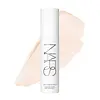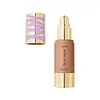What's inside
What's inside
 Key Ingredients
Key Ingredients

 Benefits
Benefits

 Concerns
Concerns

 Ingredients Side-by-side
Ingredients Side-by-side

Water
Skin ConditioningPropanediol
SolventGlycerin
HumectantSqualane
EmollientIsodecyl Neopentanoate
EmollientC9-12 Alkane
SolventPolyurethane-35
Mica
Cosmetic ColorantTrehalose
HumectantChondrus Crispus Extract
Skin ConditioningCamellia Japonica Flower Extract
EmollientTheobroma Cacao Seed Extract
AntioxidantMoringa Oleifera Seed Extract
Skin ConditioningSodium Hyaluronate
HumectantGluconolactone
Skin ConditioningMethylpropanediol
SolventCaprylyl Glycol
EmollientPhenylpropanol
MaskingHydrogenated Lecithin
EmulsifyingCoco-Caprylate/Caprate
EmollientSodium Carrageenan
Emulsion StabilisingSea Salt
AbrasivePhytosteryl/Octyldodecyl Lauroyl Glutamate
Skin ConditioningTocopherol
AntioxidantMangifera Indica Seed Butter
Skin ConditioningOrbignya Oleifera Seed Oil
EmollientPhospholipids
Skin ConditioningTocopheryl Acetate
AntioxidantHydroxyethyl Acrylate/Sodium Acryloyldimethyl Taurate Copolymer
Emulsion StabilisingPolysorbate 60
EmulsifyingSorbitan Isostearate
EmulsifyingAmmonium Acryloyldimethyltaurate/Vp Copolymer
Sodium PCA
HumectantSodium Acrylates Crosspolymer-2
AbsorbentHydrolyzed Hyaluronic Acid
HumectantXanthan Gum
EmulsifyingLecithin
EmollientSclerotium Gum
Emulsion StabilisingPullulan
Silica
AbrasiveSynthetic Fluorphlogopite
Trisodium EDTA
Sodium Citrate
BufferingCitric Acid
BufferingButylene Glycol
HumectantPentylene Glycol
Skin ConditioningDisodium Phosphate
BufferingPhenoxyethanol
PreservativeSodium Benzoate
MaskingBenzyl Alcohol
PerfumingCI 77491
Cosmetic ColorantCI 14700
Cosmetic ColorantCI 77891
Cosmetic ColorantCI 19140
Cosmetic ColorantWater, Propanediol, Glycerin, Squalane, Isodecyl Neopentanoate, C9-12 Alkane, Polyurethane-35, Mica, Trehalose, Chondrus Crispus Extract, Camellia Japonica Flower Extract, Theobroma Cacao Seed Extract, Moringa Oleifera Seed Extract, Sodium Hyaluronate, Gluconolactone, Methylpropanediol, Caprylyl Glycol, Phenylpropanol, Hydrogenated Lecithin, Coco-Caprylate/Caprate, Sodium Carrageenan, Sea Salt, Phytosteryl/Octyldodecyl Lauroyl Glutamate, Tocopherol, Mangifera Indica Seed Butter, Orbignya Oleifera Seed Oil, Phospholipids, Tocopheryl Acetate, Hydroxyethyl Acrylate/Sodium Acryloyldimethyl Taurate Copolymer, Polysorbate 60, Sorbitan Isostearate, Ammonium Acryloyldimethyltaurate/Vp Copolymer, Sodium PCA, Sodium Acrylates Crosspolymer-2, Hydrolyzed Hyaluronic Acid, Xanthan Gum, Lecithin, Sclerotium Gum, Pullulan, Silica, Synthetic Fluorphlogopite, Trisodium EDTA, Sodium Citrate, Citric Acid, Butylene Glycol, Pentylene Glycol, Disodium Phosphate, Phenoxyethanol, Sodium Benzoate, Benzyl Alcohol, CI 77491, CI 14700, CI 77891, CI 19140
Water
Skin ConditioningCyclopentasiloxane
EmollientMethyl Methacrylate Crosspolymer
Phenyl Trimethicone
Skin ConditioningButylene Glycol
HumectantCyclohexasiloxane
EmollientCaprylyl Methicone
Skin ConditioningGlycerin
HumectantPEG-10 Dimethicone
Skin ConditioningTrimethylsiloxysilicate
EmollientCyclomethicone
EmollientSorbitan Isostearate
EmulsifyingSodium Chloride
MaskingCetyl PEG/PPG-10/1 Dimethicone
EmulsifyingTriethyl Citrate
MaskingDisteardimonium Hectorite
StabilisingAluminum Hydroxide
EmollientPhenoxyethanol
PreservativeDimethicone Crosspolymer
Emulsion StabilisingTriethoxycaprylylsilane
Parfum
MaskingEthylhexylglycerin
Skin ConditioningDisodium EDTA
Benzyl Salicylate
PerfumingHexyl Cinnamal
PerfumingLimonene
PerfumingHydroxycitronellal
PerfumingGeraniol
PerfumingAmyl Cinnamal
PerfumingLinalool
PerfumingPyrus Malus Fruit Extract
Skin Conditioning1,2-Hexanediol
Skin ConditioningTremella Fuciformis Extract
HumectantHyaluronic Acid
HumectantHydrolyzed Hyaluronic Acid
HumectantSodium Hyaluronate
HumectantIron Oxides
CI 77891
Cosmetic ColorantWater, Cyclopentasiloxane, Methyl Methacrylate Crosspolymer, Phenyl Trimethicone, Butylene Glycol, Cyclohexasiloxane, Caprylyl Methicone, Glycerin, PEG-10 Dimethicone, Trimethylsiloxysilicate, Cyclomethicone, Sorbitan Isostearate, Sodium Chloride, Cetyl PEG/PPG-10/1 Dimethicone, Triethyl Citrate, Disteardimonium Hectorite, Aluminum Hydroxide, Phenoxyethanol, Dimethicone Crosspolymer, Triethoxycaprylylsilane, Parfum, Ethylhexylglycerin, Disodium EDTA, Benzyl Salicylate, Hexyl Cinnamal, Limonene, Hydroxycitronellal, Geraniol, Amyl Cinnamal, Linalool, Pyrus Malus Fruit Extract, 1,2-Hexanediol, Tremella Fuciformis Extract, Hyaluronic Acid, Hydrolyzed Hyaluronic Acid, Sodium Hyaluronate, Iron Oxides, CI 77891
Ingredients Explained
These ingredients are found in both products.
Ingredients higher up in an ingredient list are typically present in a larger amount.
Butylene Glycol (or BG) is used within cosmetic products for a few different reasons:
Overall, Butylene Glycol is a safe and well-rounded ingredient that works well with other ingredients.
Though this ingredient works well with most skin types, some people with sensitive skin may experience a reaction such as allergic rashes, closed comedones, or itchiness.
Learn more about Butylene GlycolCi 77891 is a white pigment from Titanium dioxide. It is naturally found in minerals such as rutile and ilmenite.
It's main function is to add a white color to cosmetics. It can also be mixed with other colors to create different shades.
Ci 77891 is commonly found in sunscreens due to its ability to block UV rays.
Learn more about CI 77891Glycerin is already naturally found in your skin. It helps moisturize and protect your skin.
A study from 2016 found glycerin to be more effective as a humectant than AHAs and hyaluronic acid.
As a humectant, it helps the skin stay hydrated by pulling moisture to your skin. The low molecular weight of glycerin allows it to pull moisture into the deeper layers of your skin.
Hydrated skin improves your skin barrier; Your skin barrier helps protect against irritants and bacteria.
Glycerin has also been found to have antimicrobial and antiviral properties. Due to these properties, glycerin is often used in wound and burn treatments.
In cosmetics, glycerin is usually derived from plants such as soybean or palm. However, it can also be sourced from animals, such as tallow or animal fat.
This ingredient is organic, colorless, odorless, and non-toxic.
Glycerin is the name for this ingredient in American English. British English uses Glycerol/Glycerine.
Learn more about GlycerinHydrolyzed Hyaluronic Acid is a form of hyaluronic acid. It is created by the hydrolysis of hyaluronic acid with a high molecular weight. Once created, Hydrolyzed Hyaluronic Acid has a low molecular weight.
Low molecular weight HA has been shown to hydrate and increase elasticity of the skin. Increasing elasticity is also associated with reduction of wrinkle depth.
One study found topical low molecular weight hyaluronic acid may be considered for the treatment of rosacea in the adult population. However, we always recommend speaking with a professional about your skin concerns.
Hyaluronic acids are a humectant. This means they draw moisture from the air. Hyaluronic acids help moisturize, soothe, and protect the skin.
Read more about other common forms of hyaluronic acid:
Learn more about Hydrolyzed Hyaluronic AcidPhenoxyethanol is a preservative that has germicide, antimicrobial, and aromatic properties. Studies show that phenoxyethanol can prevent microbial growth. By itself, it has a scent that is similar to that of a rose.
It's often used in formulations along with Caprylyl Glycol to preserve the shelf life of products.
Sodium Hyaluronate is hyaluronic acid's salt form. It is commonly derived from the sodium salt of hyaluronic acid.
Like hyaluronic acid, it is great at holding water and acts as a humectant. This makes it a great skin hydrating ingredient.
Sodium Hyaluronate is naturally occurring in our bodies and is mostly found in eye fluid and joints.
These are some other common types of Hyaluronic Acid:
Learn more about Sodium HyaluronateSorbitan Isostearate is an emulsifer and cleaning agent. It is created from isostearic acid and sorbitol.
As an emulsifier, Sorbitan Isostearate prevents oils and water from separating.
Due to its isostearic acid base, it may not be safe for Malassezia or fungal acne.
Learn more about Sorbitan IsostearateWater. It's the most common cosmetic ingredient of all. You'll usually see it at the top of ingredient lists, meaning that it makes up the largest part of the product.
So why is it so popular? Water most often acts as a solvent - this means that it helps dissolve other ingredients into the formulation.
You'll also recognize water as that liquid we all need to stay alive. If you see this, drink a glass of water. Stay hydrated!
Learn more about Water